2012 Hyundai Sonata eco button
[x] Cancel search: eco buttonPage 252 of 411
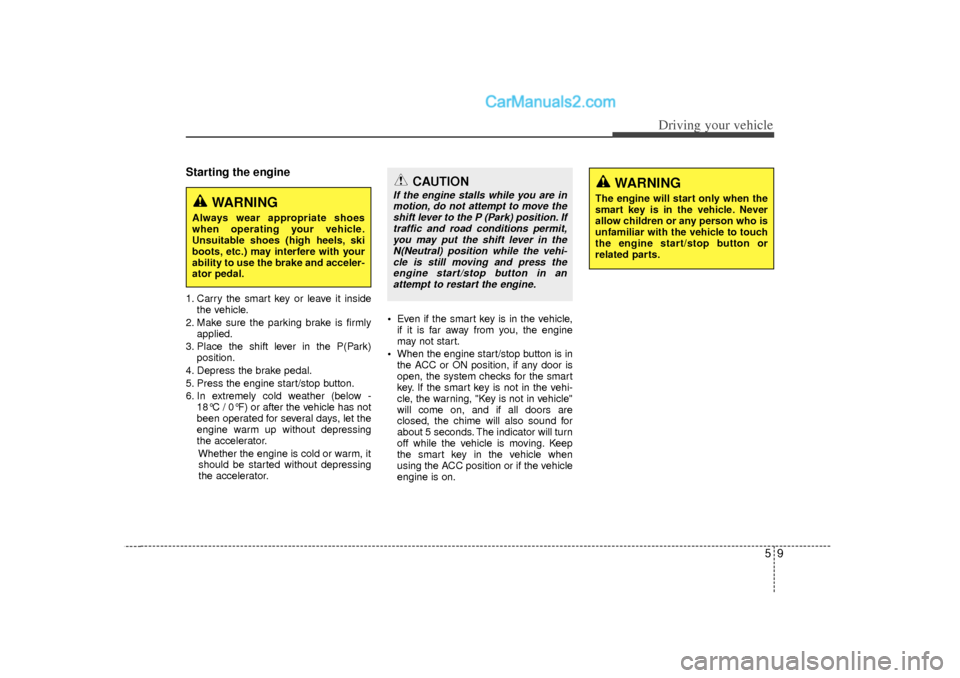
59
Driving your vehicle
Starting the engine1. Carry the smart key or leave it insidethe vehicle.
2. Make sure the parking brake is firmly applied.
3. Place the shift lever in the P(Park) position.
4. Depress the brake pedal.
5. Press the engine start/stop button.
6. In extremely cold weather (below - 18°C / 0°F) or after the vehicle has not
been operated for several days, let the
engine warm up without depressing
the accelerator.
Whether the engine is cold or warm, itshould be started without depressing
the accelerator.
Even if the smart key is in the vehicle,
if it is far away from you, the engine
may not start.
When the engine start/stop button is in
the ACC or ON position, if any door is
open, the system checks for the smart
key. If the smart key is not in the vehi-
cle, the warning, "Key is not in vehicle"
will come on, and if all doors are
closed, the chime will also sound for
about 5 seconds. The indicator will turn
off while the vehicle is moving. Keep
the smart key in the vehicle when
using the ACC position or if the vehicle
engine is on.
WARNING
Always wear appropriate shoes
when operating your vehicle.
Unsuitable shoes (high heels, ski
boots, etc.) may interfere with your
ability to use the brake and acceler-
ator pedal.
WARNING
The engine will start only when the
smart key is in the vehicle. Never
allow children or any person who is
unfamiliar with the vehicle to touch
the engine start/stop button or
related parts.
CAUTION
If the engine stalls while you are in
motion, do not attempt to move theshift lever to the P (Park) position. Iftraffic and road conditions permit, you may put the shift lever in theN(Neutral) position while the vehi-cle is still moving and press theengine start/stop button in an attempt to restart the engine.
Page 253 of 411
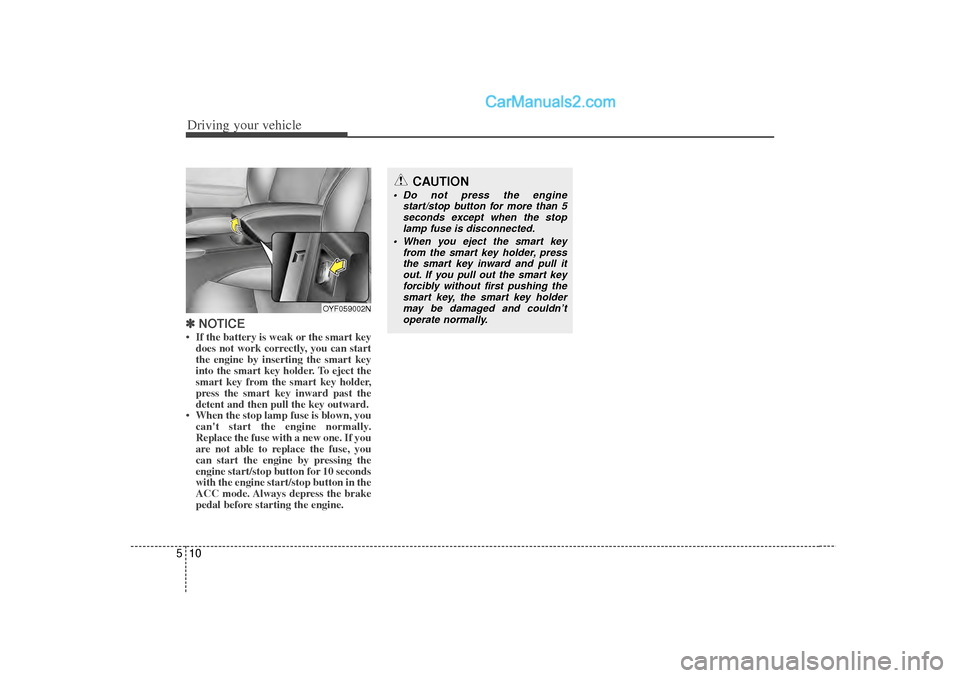
Driving your vehicle10
5✽
✽
NOTICE• If the battery is weak or the smart key
does not work correctly, you can start
the engine by inserting the smart key
into the smart key holder. To eject the
smart key from the smart key holder,
press the smart key inward past the
detent and then pull the key outward.
• When the stop lamp fuse is blown, you can't start the engine normally.
Replace the fuse with a new one. If you
are not able to replace the fuse, you
can start the engine by pressing the
engine start/stop button for 10 seconds
with the engine start/stop button in the
ACC mode. Always depress the brake
pedal before starting the engine.
OYF059002N
CAUTION
Do not press the engine
start/stop button for more than 5seconds except when the stop lamp fuse is disconnected.
When you eject the smart key from the smart key holder, pressthe smart key inward and pull it out. If you pull out the smart keyforcibly without first pushing the smart key, the smart key holdermay be damaged and couldn’t operate normally.
Page 266 of 411
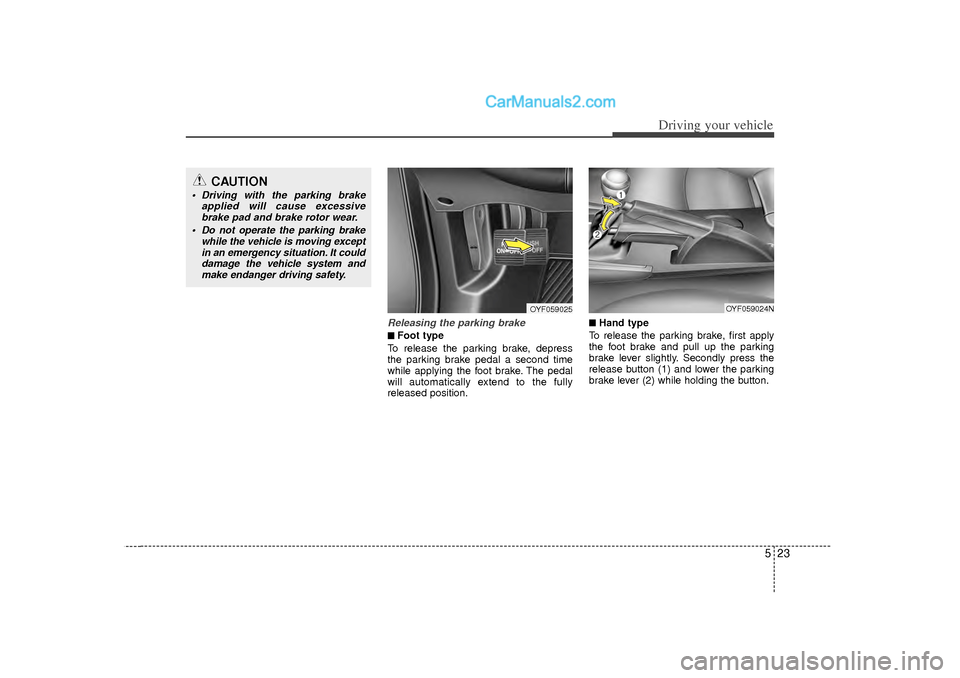
523
Driving your vehicle
Releasing the parking brake■
■Foot type
To release the parking brake, depress
the parking brake pedal a second time
while applying the foot brake. The pedal
will automatically extend to the fully
released position.
■ ■Hand type
To release the parking brake, first apply
the foot brake and pull up the parking
brake lever slightly. Secondly press the
release button (1) and lower the parking
brake lever (2) while holding the button.
CAUTION
Driving with the parking brake applied will cause excessivebrake pad and brake rotor wear.
Do not operate the parking brake while the vehicle is moving exceptin an emergency situation. It coulddamage the vehicle system and make endanger driving safety.
OYF059025
OYF059024N
Page 270 of 411
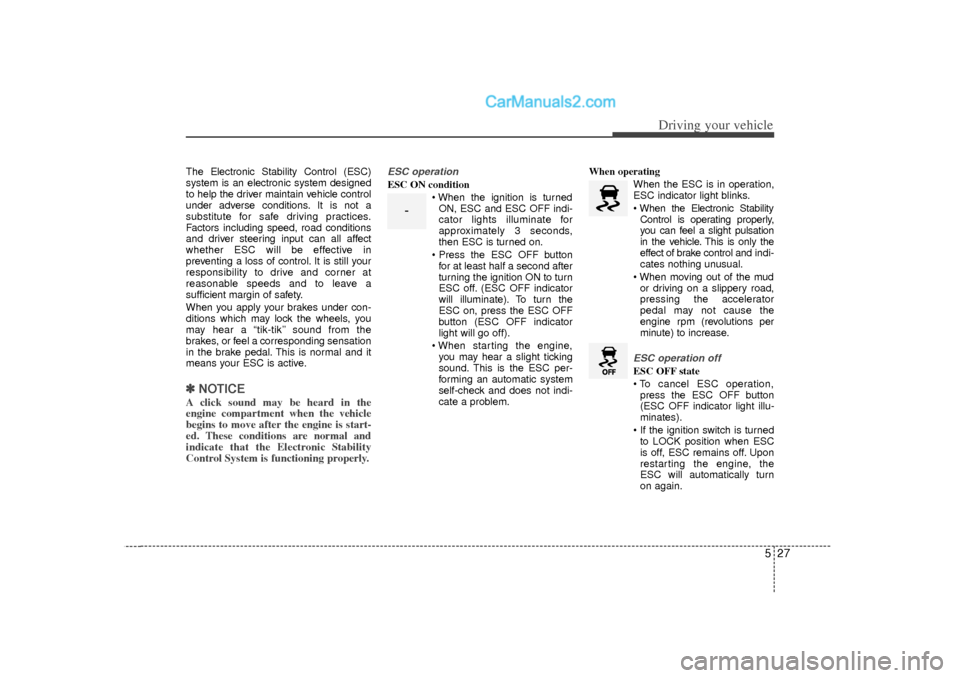
527
Driving your vehicle
The Electronic Stability Control (ESC)
system is an electronic system designed
to help the driver maintain vehicle control
under adverse conditions. It is not a
substitute for safe driving practices.
Factors including speed, road conditions
and driver steering input can all affect
whether ESC will be effective in
preventing a loss of control. It is still your
responsibility to drive and corner at
reasonable speeds and to leave a
sufficient margin of safety.
When you apply your brakes under con-
ditions which may lock the wheels, you
may hear a “tik-tik’’ sound from the
brakes, or feel a corresponding sensation
in the brake pedal. This is normal and it
means your ESC is active.✽ ✽NOTICEA click sound may be heard in the
engine compartment when the vehicle
begins to move after the engine is start-
ed. These conditions are normal and
indicate that the Electronic Stability
Control System is functioning properly.
ESC operationESC ON condition
When the ignition is turnedON, ESC and ESC OFF indi-
cator lights illuminate for
approximately 3 seconds,
then ESC is turned on.
Press the ESC OFF button for at least half a second after
turning the ignition ON to turn
ESC off. (ESC OFF indicator
will illuminate). To turn the
ESC on, press the ESC OFF
button (ESC OFF indicator
light will go off).
When starting the engine, you may hear a slight ticking
sound. This is the ESC per-
forming an automatic system
self-check and does not indi-
cate a problem. When operating
When the ESC is in operation,
ESC indicator light blinks.
When the Electronic StabilityControl is operating properly,
you can feel a slight pulsation
in the vehicle. This is only the
effect of brake control and indi-
cates nothing unusual.
When moving out of the mud or driving on a slippery road,
pressing the accelerator
pedal may not cause the
engine rpm (revolutions per
minute) to increase.
ESC operation offESC OFF state
To cancel ESC operation,press the ESC OFF button
(ESC OFF indicator light illu-
minates).
If the ignition switch is turned to LOCK position when ESC
is off, ESC remains off. Upon
restarting the engine, the
ESC will automatically turn
on again.
-
Page 278 of 411
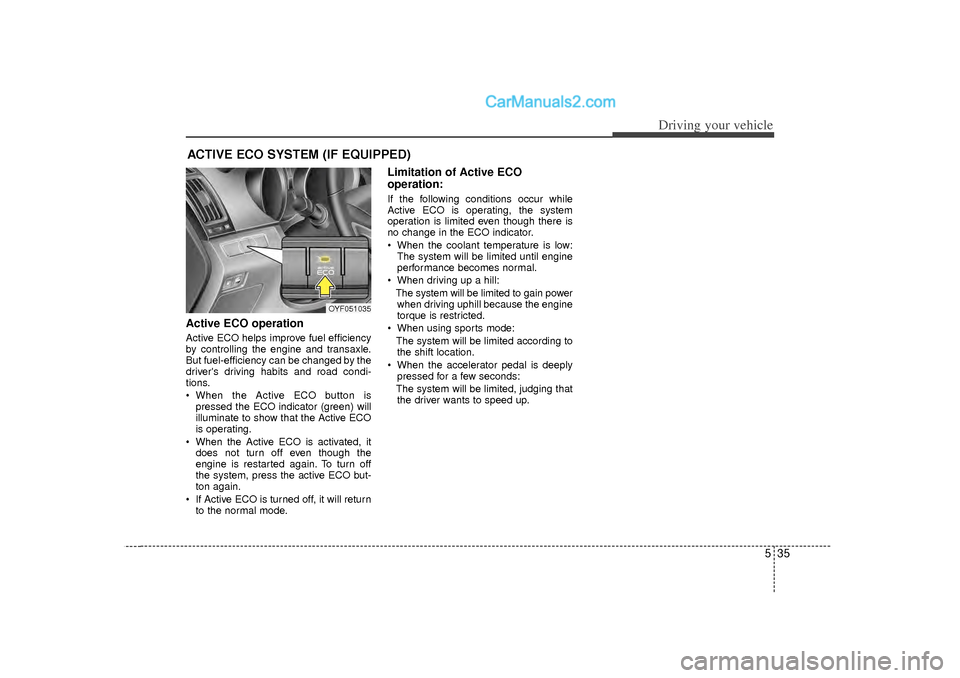
535
Driving your vehicle
Active ECO operation Active ECO helps improve fuel efficiency
by controlling the engine and transaxle.
But fuel-efficiency can be changed by the
driver's driving habits and road condi-
tions.
When the Active ECO button ispressed the ECO indicator (green) will
illuminate to show that the Active ECO
is operating.
When the Active ECO is activated, it does not turn off even though the
engine is restarted again. To turn off
the system, press the active ECO but-
ton again.
If Active ECO is turned off, it will return to the normal mode.
Limitation of Active ECO
operation:If the following conditions occur while
Active ECO is operating, the system
operation is limited even though there is
no change in the ECO indicator.
When the coolant temperature is low:The system will be limited until engine
performance becomes normal.
When driving up a hill: The system will be limited to gain powerwhen driving uphill because the engine
torque is restricted.
When using sports mode: The system will be limited according tothe shift location.
When the accelerator pedal is deeply pressed for a few seconds:
The system will be limited, judging that the driver wants to speed up.
ACTIVE ECO SYSTEM (IF EQUIPPED)
OYF051035
Page 403 of 411
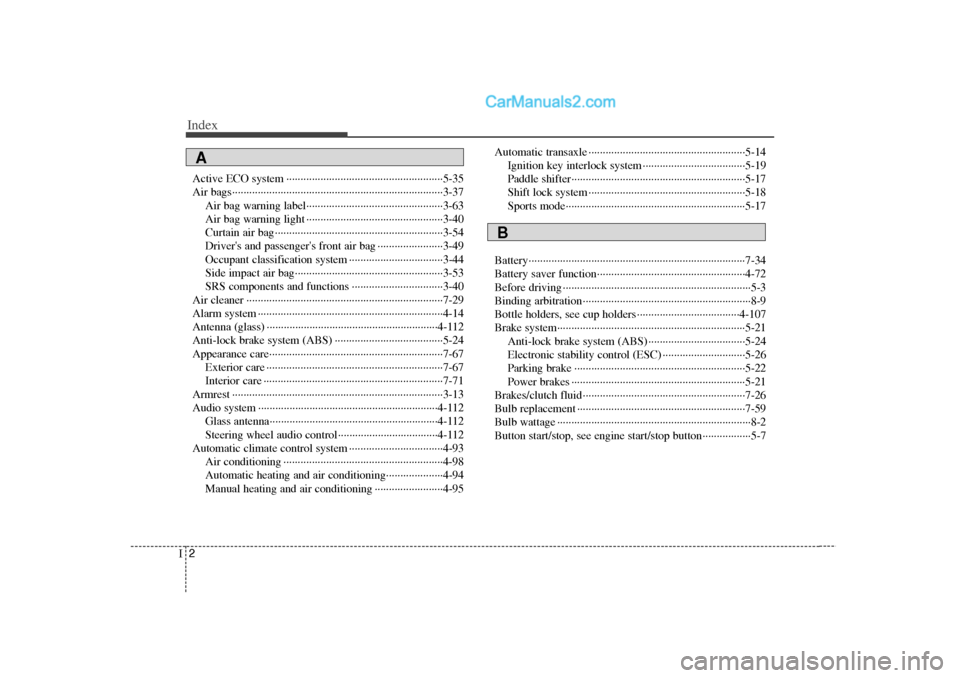
Index2I
Active ECO system ··················\
··················\
··················\
·5-35
Air bags··················\
··················\
··················\
··················\
··3-37Air bag warning label··················\
··················\
············3-63
Air bag warning light ··················\
··················\
············3-40
Curtain air bag··················\
··················\
··················\
·····3-54
Driver's and passenger's front air bag ··················\
·····3-49
Occupant classification system ··················\
···············3-44
Side impact air bag··················\
··················\
················3-53
SRS components and functions ··················\
··············3-40
Air cleaner ··················\
··················\
··················\
···············7-29
Alarm system ··················\
··················\
··················\
···········4-14
Antenna (glass) ··················\
··················\
··················\
······4-112
Anti-lock brake system (ABS) ··················\
··················\
··5-24
Appearance care··················\
··················\
··················\
·······7-67 Exterior care ··················\
··················\
··················\
········7-67
Interior care ··················\
··················\
··················\
·········7-71
Armrest ··················\
··················\
··················\
··················\
··3-13
Audio system ··················\
··················\
··················\
·········4-112 Glass antenna··················\
··················\
··················\
·····4-112
Steering wheel audio control··················\
·················4-112
Automatic climate control system ··················\
···············4-93 Air conditioning ··················\
··················\
··················\
··4-98
Automatic heating and air conditioning··················\
··4-94
Manual heating and air conditioning ··················\
······4-95 Automatic transaxle ··················\
··················\
··················\
·5-14
Ignition key interlock system ··················\
··················\
5-19
Paddle shifter··················\
··················\
··················\
·······5-17
Shift lock system ··················\
··················\
··················\
·5-18
Sports mode··················\
··················\
··················\
·········5-17
Battery··················\
··················\
··················\
··················\
····7-34
Battery saver function··················\
··················\
················4-72
Before driving ··················\
··················\
··················\
············5-3
Binding arbitration ··················\
··················\
··················\
·····8-9
Bottle holders, see cup holders ··················\
··················\
4-107
Brake system··················\
··················\
··················\
············5-21 Anti-lock brake system (ABS) ··················\
················5-24
Electronic stability control (ESC) ··················\
···········5-26
Parking brake ··················\
··················\
··················\
······5-22
Power brakes ··················\
··················\
··················\
·······5-21
Brakes/clutch fluid ··················\
··················\
··················\
···7-26
Bulb replacement ··················\
··················\
··················\
·····7-59
Bulb wattage ··················\
··················\
··················\
··············8-2
Button start/stop, see engine start/stop button·················5-7A
B
Page 405 of 411
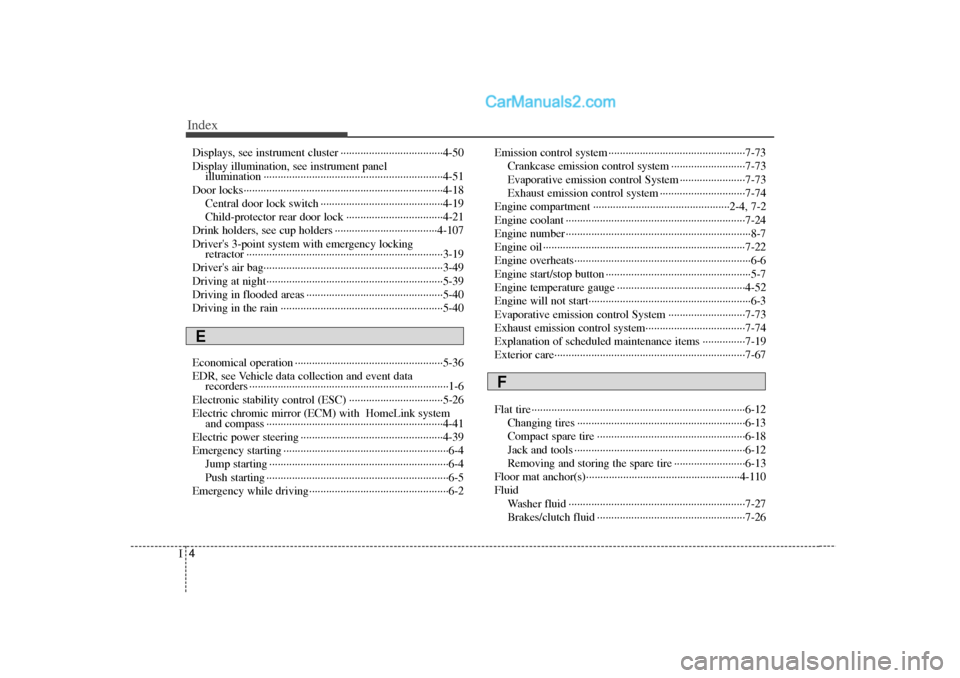
Index4I
Displays, see instrument cluster ··················\
··················\
4-50
Display illumination, see instrument panelillumination ··················\
··················\
··················\
·········4-51
Door locks··················\
··················\
··················\
················4-18 Central door lock switch ··················\
··················\
·······4-19
Child-protector rear door lock ··················\
················4-21
Drink holders, see cup holders ··················\
··················\
4-107
Driver's 3-point system with emergency locking retractor ··················\
··················\
··················\
···············3-19
Driver's air bag··············\
··················\
··················\
·············3-49
Driving at night··················\
··················\
··················\
········5-39
Driving in flooded areas ··················\
··················\
············5-40
Driving in the rain ··················\
··················\
··················\
···5-40
Economical operation ··················\
··················\
················5-36
EDR, see Vehicle data collection and event data recorders ··················\
··················\
··················\
················1-6
Electronic stability control (ESC) ··················\
···············5-26
Electric chromic mirror (ECM) with HomeLink system and compass ··················\
··················\
··················\
········4-41
Electric power steering ··················\
··················\
··············4-39
Emergency starting ··················\
··················\
··················\
····6-4 Jump starting ··················\
··················\
··················\
·········6-4
Push starting ··················\
··················\
··················\
··········6-5
Emergency while driving··················\
··················\
·············6-2 Emission control system ··················\
··················\
············7-73
Crankcase emission control system ··················\
········7-73
Evaporative emission control System ··················\
·····7-73
Exhaust emission control system ··················\
············7-74
Engine compartment ··················\
··················\
············2-4, 7-2
Engine coolant ··················\
··················\
··················\
·········7-24
Engine number ··················\
··················\
··················\
···········8-7
Engine oil ··················\
··················\
··················\
·················7-22\
Engine overheats··················\
··················\
··················\
········6-6
Engine start/stop button ··················\
··················\
···············5-7
Engine temperature gauge ··················\
··················\
·········4-52
Engine will not start··················\
··················\
··················\
···6-3
Evaporative emission control System ··················\
·········7-73
Exhaust emission control system··················\
·················7-74\
Explanation of scheduled maintenance items ···············7-19
Exterior care··················\
··················\
··················\
·············7-67
Flat tire ··················\
··················\
··················\
··················\
···6-12 Changing tires ··················\
··················\
··················\
·····6-13
Compact spare tire ··················\
··················\
················6-18
Jack and tools ··················\
··················\
··················\
······6-12
Removing and storing the spare tire ··················\
·······6-13
Floor mat anchor(s)··················\
··················\
··················\
4-110
Fluid Washer fluid ··················\
··················\
··················\
········7-27
Brakes/clutch fluid ··················\
··················\
················7-26E
F